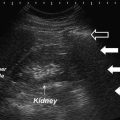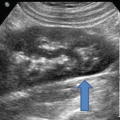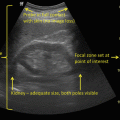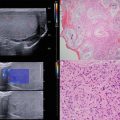The following is extracted from the AIUM training guidelines approved October 31, 2015. The current training guidelines can be found at http://www.aium.org/officialStatements/53. (Reproduced with permission of the American Institute of Ultrasound in Medicine)
Physicians who perform and/or interpret diagnostic ultrasound examinations in the practice of urology should be licensed medical practitioners who have a thorough understanding of the indications and guidelines for genitourinary ultrasound examinations as well as a familiarity with the basic physical principles and limitations of the technology of ultrasound imaging. They should be familiar with alternative and complementary imaging and diagnostic procedures and should be capable of correlating the results of these other procedures with the ultrasound findings. They should have an understanding of ultrasound technology and instrumentation, ultrasound power output, equipment calibration, and safety. Physicians responsible for diagnostic genitourinary ultrasound examinations should be able to demonstrate familiarity with the anatomic, physiologic, and pathophysiologic characteristics of the anatomic areas that are being examined. These physicians should provide evidence of the training and competence needed to perform and/or interpret diagnostic urologic ultrasound examinations successfully. The training should include methods of documentation and reporting of ultrasound studies
Physicians performing and/or interpreting diagnostic urologic examinations should meet at least one of the following criteria:
1. Completion of an accredited urologic residency that includes training in ultrasound since July 1, 2009 (the year reporting of ultrasound examinations was required by the residency review committee), and is board certified by the American Board of Urology or is board eligible. If completion of certification occurred more than 36 months ago, maintenance of competence must be demonstrated, such as 50 diagnostic urologic ultrasound examinations per year and a total of ten AMA PRA Category 1 Credits™ within the previous 36 monthsa
2. Board certification in urology before July 1, 2009, and submission of an attestation of experience including involvement with 100b diagnostic urologic ultrasound examinations and training in urologic ultrasound that includes at least a minimum of 12 AMA PRA Category 1 Credits™; or level 2 course(s) verifying that the individual has satisfactorily met all specified learning objectives for the level 2 classification course(s) including hands-on demonstration of successfully performing and documenting ultrasound studies. Continuing medical education courses must be approved by the American Urological Association Office of Education or AIUM and include both didactic and hands-on ultrasound. If the level 2 course was completed more than 36 months ago, maintenance of competence must be demonstrated, such as 50 diagnostic urologic ultrasound examinations per year and a total of ten AMA PRA Category 1 Credits™ within the previous 36 monthsa
3. Completion of an accredited residency program and/or fellowship or postgraduate training (other than in urology) that includes structured training in diagnostic urologic ultrasound, under the supervision of a qualified physician(s),c during which the trainee will have evidence of being involved with the performance, evaluation, interpretation, and reporting of at least 100b diagnostic urologic ultrasound examinations
If completion of a residency and/or fellowship program occurred more than 36 months ago:
(a) The supervision and/or performance, interpretation, and reporting of at least 100b diagnostic urologic ultrasound examinations in the previous 36 months must be demonstrated; and
(b) Fifteen AMA PRA Category 1 Credits™ dedicated to diagnostic urologic ultrasound must be documented within the previous 36 monthsa
4. For completion of an accredited residency program and/or fellowship (other than in urology) in which the physician did not receive the required structured training in diagnostic urologic ultrasound, acceptable clinical experience can be documented by demonstrating:
(a) Evidence of being involved with the performance, evaluation, interpretation, and reporting of at least 100b diagnostic urologic ultrasound examinations within the previous 36 months. It is expected that in most circumstances, examinations will be under the supervision of a qualified physician(s);c and
(b) Evidence of 30 AMA PRA Category 1 Credits™ dedicated to diagnostic urologic ultrasound within the previous 36 monthsa
Maintenance of competence in urologic ultrasound
All physicians performing urologic ultrasound examinations should demonstrate evidence of continuing competence in the interpretation and reporting of those examinations. A minimum of 50 diagnostic genitourinary ultrasound examinations per year is recommended to maintain the physician’s skills
Continuing medical education in urologic ultrasound
The physician should complete 10 h of AMA PRA Category 1 Credits™ specific to urologic ultrasound every 3 years
Developed in collaboration with the following organization:
American Urological Association
Each interpreting physician must have participated in at least 100 genitourinary ultrasound examinations prior to submitting the application, and must participate in at least 150 genitourinary ultrasound in the 3 years prior to reaccreditation [14].
Once the practice is accredited, each interpreting physician must obtain a minimum of ten AMA PRA Category 1 Credits™ in genitourinary ultrasound every 3 years [14].
Sonographers (if applicable)
Name
Involvement with ultrasound functions
Certification
Training
Specialty/specialties performed
Length of time with practice
Each sonographer or other nonphysician who performs ultrasound examinations for the practice must be or become appropriately certified prior to reaccreditation (in 3 years). The AIUM currently recognizes certification in abdominal ultrasound by the American Registry of Diagnostic Medical Sonography (ARDMS) and general sonography certification granted by the American Registry of Radiologic Technologists (ARRT) obtained after January 1, 2013 [14].
Additional personnel (if applicable)
Name
Involvement with ultrasound functions
Within 1 week of submitting the online application, the practice must submit the following to the AIUM:
- 1.
Payment (if not already paid online).
The nonrefundable accreditation fee is automatically calculated based on the number of specialties in which the practice seeks accreditation, the number of sites the practice would like to have accredited, and the number of machines the practice has [17].
- 2.
The Accreditation Agreement.
The Accreditation Agreement defines the relationship between the AIUM and the practice seeking accreditation. It includes a HIPAA addendum by which the practice names the AIUM as its Business Associate. Review of the application cannot begin without this agreement. The AIUM will also sign the agreement and forward you a copy for your HIPAA records [18].
Stay updated, free articles. Join our Telegram channel

Full access? Get Clinical Tree








